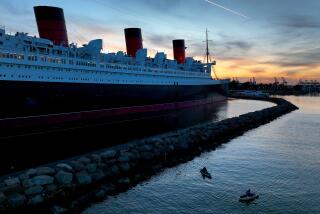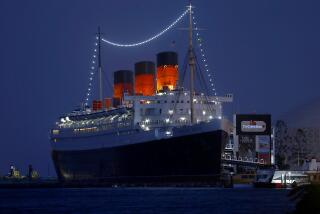Cruising Asia’s modern miracles and ancient wonders aboard the Ocean Princess
On a windy, showery February evening midway through our 16-night cruise from Laem Chabang, Thailand, to Shanghai, my wife, Laurel, and I stood on the balcony of our stateroom aboard the Ocean Princess, berthed at the tip of the Kowloon Peninsula. Across Victoria Harbour, the astonishing array of skyscrapers on Hong Kong Island had grown lively with light, a multicolored, ever-changing display of patterns and advertising icons — and there was more to come.
The ubiquitous Star Ferries — green and white, double-ended, distinctive in profile — scuttled back and forth, and other excursion boats joined the armada. Then, at 8 o’clock, laser beams, white and blue, erupted from buildings, further brightening the swirling clouds, and we felt ourselves at the magical heart of things — finally.
Until then, our cruise might have been called “The Great Container Ports of Southeast Asia.” We’d sailed from Laem Chabang, a two-hour cab ride from Bangkok. After tendering into Koh Samui, our second port, also in Thailand, we docked in Singapore at an immaculate and orderly terminal, distant from the heart of the city, with acres of containers stacked as neatly as dominoes.
The biggest disappointment came next when the ship docked at Phu My instead of continuing up the Saigon River to Ho Chi Minh City. This meant 21/2 hours of bus travel in each direction, leaving us little more than three hours to explore this frenetic city, where motorbikes swarmed like hornets. We rushed through the Reunification Palace, the Rex Hotel and the Ben Thanh Market, grabbed a quick lunch, then, breathless, reboarded the bus, most sights unseen.
Planning your trip
Ocean Princess, (800) 774-6237, https://www.princess.com, will make four Asian cruises similar to ours, plus two longer ones, from February through April. Fares begin at $2,895 per person. Our cruise cost just under $2,000 per person, including insurance — and port charges and government taxes, which were substantial, though we still thought this was an excellent value for 16 nights in a balcony cabin.
For Laurel and me, the Ocean Princess’ small size (our voyage was sold out with 652 passengers) had more to recommend it than just the port access it sometimes allowed. In fact, the vessel had everything we could wish for: a spacious, well-designed dining room, the Club Restaurant, with an adjoining bar; two alternative dinner spots (with a cover charge), the Sterling Steakhouse and the Italian-themed Sabatini’s Restaurant; the Tahitian Lounge, with floor-to-ceiling windows; an open promenade deck with views of the sea and wooden deck chairs (and deck blankets, which I chose to call “steamer rugs”); the Casino Bar, which takes its name from its proximity to the ship’s modest gambling venue but is really a cozy piano bar; and a fine library.
British roots onboard
The Casino Bar, Club Bar and library seemed right out of a British country house, with dark wood paneling, fireplaces (faux, of course), wing chairs and comfy sofas. The Casino Bar’s only awkward touch was the wall of fake books behind the piano, the imperfect illusion fully blown when it was opened to control the room’s electronics.
The library’s books, of course, were real and plentiful, well selected and ordered. I happily repaired here when the winds blew so fiercely that the outer decks were declared off-limits or, during the final, most northern part of the cruise, when the weather was too cold even for steamer rugs. The wood paneling creaked companionably as the ship flexed in the high seas — a sound, like the room itself, reminiscent of the old liners.
We chose the Tahitian Lounge for cocktails when the lingering light of late sunsets — or the sparkling skyscrapers of Hong Kong — offered vistas. Otherwise, we preferred the Casino Bar, where we listened to Aussie David Crathorne play show tunes and old favorites. There, our drinks were served by Liseth, a Peruvian bar steward just arrived from Cuzco. She may have needed a quick study on the subtleties of unfamiliar cocktails, but she had nothing more to learn about charm.
Cabins tend to be cookie-cutter spaces and much alike from cruise line to cruise line, but we thought ours on the Ocean Princess was unusually comfortable and handsomely decorated, with furnishings tending toward French Provincial. The loveseat, coffee table and vanity were at the outboard end, separated by a wall of glass from the balcony, which was the best feature of all.
Football, lectures and a choir
The Ocean Princess, of course, had other spaces: The spa, a tad pricey as always on shipboard, and attached exercise room with a view of the sea; the Panorama Buffet, serving from early morning through late evening, and the Cabaret Lounge, the venue for performances, parties, movies and lectures. For us, its most significant events were the Super Bowl, which we watched on three giant screens amid a large, vocal crowd; the invaluable talks by Hutch, the port lecturer; two captain’s cocktail parties; and the passenger talent show “featuring the Amazing Ocean Princess Choir.”
This chorus was organized by Crathorne, who held rehearsals every sea day (there was one between each pair of ports, an ideal arrangement, allowing R&R to alternate with energetic touring). When this group —15 strong, Laurel among them — appeared onstage, tricked out in black and white and singing a program that included songs from “West Side Story,” I couldn’t have been prouder. (“That was better than the shows,” I heard a passenger say as we were leaving.)
Two captain’s cocktail parties were an anomaly, occasioned by a change of command in mid-cruise, also unusual. Captains do set the tone for life onboard, and both Stefano Ravera and Carlo Servillo, who replaced Ravera when he began his vacation, were attractive presences around the vessel. Capt. Ravera, who often turned up for a swim in the pool, stopped by to chat with us most evenings in the Casino Bar. There, on his last night, he requested the wistful “Lili Marleen” and shook hands with the stewards on duty.
Hutch’s talks typically took place three days before each port call, allowing ample time for planning — and for canceling pre-booked, ship-sponsored shore excursions, which in most cases we did. Hutch has been at sea since 1984 in roles as varied as chief purser, cruise director and port lecturer. With his good, specific advice, we negotiated most ports on our own.
Birthplace of Singapore slings
In Singapore, we took the metro (with an inexpensive day pass) to Raffles, one of the world’s great hotels, resplendent after its recent restoration, where we walked in the garden, envied the $135 (U.S.) Sunday brunch in the Bar & Billiard Room (where W. Somerset Maugham and Noel Coward once drank), and caved in and ordered Singapore slings at the Long Bar, their reputed birthplace. As Hutch had warned us, they were the most expensive ($18) and vilest drinks we’d ever quaffed, but we just had to.
We walked to Clarke Quay for a short boat tour on the Singapore River, passing the Merlion fountain (an iconic spouting statue of a lion with a fish’s tail), then had a riverside lunch at Jumbo. We ate the local specialty, chile crab, dished up in a wok, slathered with chile sauce and served with a cracker, chopsticks and no napkins. The crustaceans were delicious, but we practically had to be hosed down after we finished. After a jaunt to Little India, we headed back to the ship.
In Hong Kong, on the lunar new year, we used our Octopus card (a debit transit card good on all public transport) to take a ride on the double-deck trams, then hop a bus to Aberdeen on the far side of Hong Kong Island to the ur-Jumbo for a dim sum lunch, a local New Year’s Day tradition at the huge floating restaurant on three levels.
From the Taiwanese port of Keelung, we took a local train to Taipei, then the metro to Taipei 101, the idiosyncratic skyscraper, reminiscent of a bamboo stalk, that once was the world’s tallest. Though we were warned that visibility was nil, we rode the world’s fastest elevator to the observatory. In Okinawa, our last port, a monorail took us to Shurijo Castle Park, a post- World War II reconstruction of structures that had evolved over centuries.
Only in Vietnam did we buy organized shore excursions, and, with Duc, our excellent guide, the tour to Da Nang and Hoi An — an ancient trading center and now a World Heritage Site — was successful. But it was always good to get back to our ship — “your mobile home,” Duc called it.
More to Read
Sign up for The Wild
We’ll help you find the best places to hike, bike and run, as well as the perfect silent spots for meditation and yoga.
You may occasionally receive promotional content from the Los Angeles Times.






